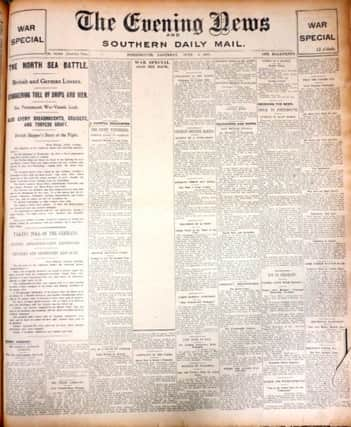How The News reported on the Battle of Jutland


The Secretary of the Admiralty first broke the news two days after the fight, in which it was revealed that the battle cruisers HMS Queen Mary, HMS Indefatigable, HMS Invincible and the cruisers HMS Defence and HMS Black Prince had all been sunk.
It was an announcement that rocked the nation and dominated the front page of The Evening News for the next week.
Advertisement
Hide AdAdvertisement
Hide AdIn the revelation, it was also unveiled that HMS Warrior was too badly damaged and had to be abandoned, and destroyers HMS Tipperary, HMS Turbulent, HMS Fortune, HMS Sparrowhawk and HMS Ardent had all been lost while the whereabouts of six other ships were unknown.
Seven of the ships destroyed were from Portsmouth.
In the days that followed, reports began to surface which falsely claimed flying German Zeppelins had been used to bomb ships.
There was much confusion over the details of what took place in that pivotal 36 hours in the North Sea.
Eventually the true horror of the battle was revealed.
First came an eye-witness account from the skipper of a British trawler John Brown, who described how shells were zipping over his ship.
Advertisement
Hide AdAdvertisement
Hide AdThe Evening News reported on June 3, 1916, how the skipper, known only as I. Punt, was left stunned after witnessing an enormous German fleet of at least 50 warships cruising towards the British armada.
He described the moment gunfire erupted just two miles from his position as the two navies went toe-to-toe in the opening hours of the battle.
The following day, the true scale of Britain’s losses began to surface.
The News’ front page was dominated by the headline ‘The North Sea Battle’.
Advertisement
Hide AdAdvertisement
Hide AdAnother statement from the Admiralty broke the news that a number of Portsmouth ships had been obliterated, with just a handful of survivors left.
All but four of HMS Queen Mary’s ship’s company had been wiped out. Likewise, it was a similar story for HMS Invincible, which had just five of its crew left, while all of HMS Black Prince’s and HMS Indefatigable’s ship’s company had been killed
HMS Defence lost all but one of her ship’s company while it was brighter news for HMS Warrior, with all but one of her crew having been saved.
June 5’s edition was packed with ‘thrilling stories’ of the battle.
Advertisement
Hide AdAdvertisement
Hide AdOne account followed the harrowing final moments of Queen Mary which, outnumbered, fought valiantly to the bitter end.
An eyewitness featured in The News described how it appeared as if Queen Mary ‘took on the whole German Navy by herself’.
On the same day, it was reported how 18 German ships had been sunk compared to just 14 British - the actual figure was only 11 German vessels. One of the survivors from Warrior said: ‘We gave them a terrible drubbing, much worse than the Germans are owning up to.
‘Why we ourselves sunk two light cruisers and a destroyer before we were done in and the Tiger sank five or six destroyers.’
Advertisement
Hide AdAdvertisement
Hide AdHe added: ‘We saw Queen Mary blow up as the result of heavily concentrated fire.
‘It looked as if her magazine exploded. She just broke in two and went down like a stone.
‘The indefatigable went down in much the same way. She had given the enemy a devil of a pounding and they gave the same to her.’
Another British seaman described a scene of devastation.
‘Shells dropped around us like hail and some of them hit us, but luckily none did any vital damage or even put a gun out of action,’ he said.
Advertisement
Hide AdAdvertisement
Hide Ad‘Several dented our armour. I have seen one plate with a dent six inches deep in the steel.’
He added that the Germans ‘ran for the safety of their ports and minefields’ when they became overwhelmed by the Royal Navy.
In Portsmouth, families held a vigil by the city’s naval base, waiting for news of their loved ones.
The atmosphere was a sober one while they waited.
Eventually, on Sunday, June 4, the first load of survivors entered the city by train and were marched to the naval barracks.
Advertisement
Hide AdAdvertisement
Hide AdAs The News reported: ‘Many of the men were those who were not aboard their vessels at the time of the fight, but others had been through the terrible ordeal and had been picked up and landed at north-east ports.
‘They were dressed apparently in borrowed garments, and went through the streets without the passer-by being aware as to who they were.
‘Later in the day they were released and the majority hurried to their homes to rejoin their anxious friends.’